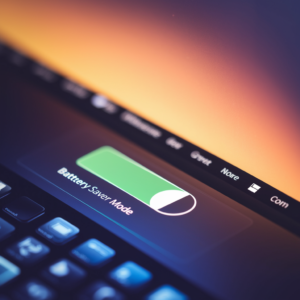💡 DIY Computer Fixes?
Grab my easy step-by-step guide and keep your computer running like new.
Check Your Laptops Battery in Windows
Laptops have become essential tools for work, school, and entertainment, making battery health an important factor to consider. A laptop’s battery life can greatly impact your productivity, and when your battery starts to degrade, it can become frustrating to work on a device that doesn’t last as long as it used to. Fortunately, Windows 10 offers built-in tools that let you monitor and check your laptop’s battery health, ensuring that you can take action before any major issues arise.
In this blog post, we’ll walk you through the process of checking your laptop’s battery health in Windows 10, why it’s important, and some tips for prolonging your battery’s lifespan.
Why Battery Health is Important for Your Laptop
Before we dive into the steps, it’s essential to understand why monitoring your laptop’s battery health matters. Most laptops today use lithium-ion batteries, which have a finite lifespan. Over time, these batteries will lose their ability to hold a charge, and as the battery health degrades, your laptop’s performance will suffer. In some cases, you might even experience unexpected shutdowns or an inability to charge the battery completely.
By checking the battery health, you can make informed decisions about whether your battery needs to be replaced, or if there are steps you can take to improve its performance.
How to Check Your Laptop’s Battery Health Using Windows 10
Windows 10 offers an easy-to-use battery report feature that lets you check your laptop’s battery health. Here’s how you can generate a detailed battery report:
Step 1: Generate a Battery Report in Windows 10
- Press Windows + X and select Command Prompt (Admin) or Windows PowerShell (Admin) from the menu. This opens a command-line interface with administrative privileges.
- In the command prompt window, type the following command:
- Press Enter. This command will generate a battery report and save it as an HTML file.
- The file will be saved in your user folder (usually C:UsersYourUsername). The report will be named battery-report.html.
- Open the file by double-clicking it. The report will be displayed in your default web browser.
The battery report will contain a wealth of information about your laptop’s battery, including its design capacity, current capacity, charge cycles, and battery life over time.

Check Your Laptops Battery in Windows
Step 2: Analyze Your Battery Report
When you open the battery report, you’ll see a detailed overview of your battery’s health. Here are some of the key sections and metrics to focus on:
-
Design Capacity vs. Full Charge Capacity
The report will show two key metrics: the design capacity (how much charge the battery was designed to hold when new) and the full charge capacity (the current maximum charge your battery can hold). A significant drop in the full charge capacity compared to the design capacity indicates that your battery has lost some of its ability to hold a charge. -
Battery Health Estimates
If the full charge capacity is significantly lower than the design capacity, it’s an indication that your battery is aging and may need to be replaced soon. While some loss of capacity over time is normal, a drastic drop means it may be time to replace the battery to avoid further inconvenience. -
Battery Life History
The report will also show a history of your laptop’s battery life over the last few days. This section can help you determine if your battery is consistently underperforming or if there has been a sudden drop in performance. -
Charge Cycles
Each time your laptop battery goes from fully charged to fully discharged, it counts as one charge cycle. The report will show how many charge cycles your battery has gone through. Typically, a lithium-ion battery can last for around
Step 3: Evaluate Your Battery’s Status
Using the information from your battery report, you can determine whether your battery needs to be replaced or if there are other steps you can take to optimize its performance.

Check Your Laptops Battery in Windows
Additional Ways to Monitor Battery Health in Windows 10
While the built-in battery report tool is the most comprehensive way to check your laptop’s battery health, there are other ways to monitor the battery’s condition in real-time.
Power Options Menu: Check Battery Status
Another quick way to check your battery’s status is through the Power Options menu in Windows 10:
- Right-click the battery icon in the taskbar.
- Select Power Options.
- Here, you can see basic information about the battery, such as whether it’s charging, the percentage of battery life left, and the selected power plan.
- If the battery icon indicates a Battery not charging or Plugged in, not charging message, it may be a sign of a deeper issue with your battery or charging system.
Battery Saver Mode
Windows 10 also has a Battery Saver Mode that helps conserve power by limiting background activity and push notifications. While this doesn’t directly show your battery’s health, using it can extend your battery life when it’s running low.
You can activate Battery Saver mode by clicking on the battery icon in the taskbar and dragging the slider to the left.
Third-Party Apps
For users who want more detailed information about their battery health, third-party apps like BatteryCare and HWMonitor provide more insights into the battery’s temperature, wear level, and other key statistics.

Tips for Extending Your Laptop Battery’s Lifespan
Even if your battery is in good health, there are several ways you can extend its lifespan and keep it functioning properly for longer. Here are some quick tips:
Avoid Extreme Temperatures
High heat and cold temperatures can cause significant damage to your battery over time. Always try to use your laptop in a temperature-controlled environment, ideally between 50°F and 95°F (10°C to 35°C).
Optimize Your Power Settings
Adjust your laptop’s power settings for optimal battery performance. Choose a Power Saver or Balanced power plan to conserve battery life. You can access these options by going to Control Panel > Power Options.
Don’t Let the Battery Drain Completely
Avoid completely draining your laptop’s battery on a regular basis. It’s better to plug your laptop in when it reaches around 20-30% to avoid unnecessary strain on the battery.
Unplug When Fully Charged
Once your laptop reaches 100% battery, it’s a good idea to unplug it. Keeping your laptop plugged in for extended periods can lead to heat buildup, which can affect the battery’s health over time.
Regularly Check Your Battery Health
As discussed earlier, checking your battery’s health using the built-in battery report in Windows 10 is an essential step in monitoring your battery’s performance. By doing this regularly, you’ll have a better idea of when your battery might need replacing.

Check Your Laptops Battery in Windows
Your laptop’s battery is crucial to its overall performance, and monitoring its health regularly can help you avoid unexpected shutdowns or performance issues. By using Windows 10’s built-in tools and implementing best practices for battery care, you can ensure that your battery lasts longer and functions optimally.
If your battery’s health has significantly degraded, it may be time for a replacement. In that case, be sure to consult your laptop manufacturer for compatible replacement batteries.

Check Your Laptops Battery in Windows
Need computer help?
I have customers all over the U.S., and can help you no matter where you live.
That Tech Jeff is an online computer repair service that helps with PC and Mac computers.
Services: Computer help, printer help, and email help.
Flat rate pricing
No charge if the problem can’t be fixed
Works online with clients who have an internet connection and a computer that turns on.
Reviews
Clients say that Jeff is quick to respond and goes above and beyond to fix issues.
Clients say that Jeff is especially good with beginners and seniors.
That Tech Jeff has been working online since 2007



